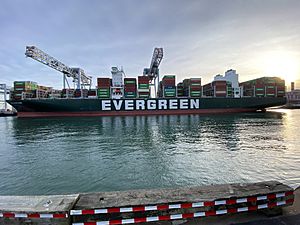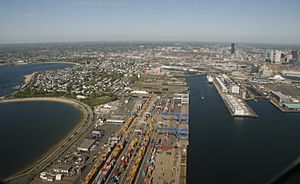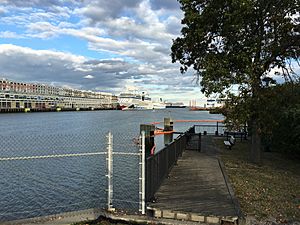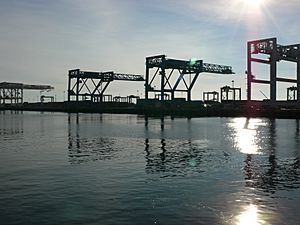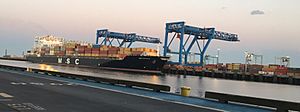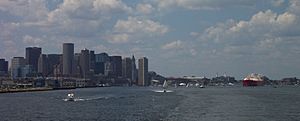Port of Boston facts for kids
Quick facts for kids Port of Boston |
|
|---|---|
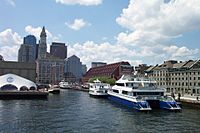 |
|
| Location | |
| Country | |
| Location | Boston, Suffolk County, MA |
| Coordinates | 42°21′48.96″N 71°2′11.77″W / 42.3636000°N 71.0366028°W |
| Details | |
| Operated by | Massachusetts Port Authority (Massport) |
| Owned by | Government of Massachusetts |
| Type of harbor | Natural/artificial |
| Size of harbor | 500 acres (200 ha) |
| Port Director | Lisa Wieland |
| Draft depth | 40 feet |
| Air draft | Unrestricted |
| Website ]http://www.massport.com/ www.massport.com] |
|
The Port of Boston is a very busy seaport located in Boston Harbor, right next to the City of Boston. It's the biggest port in Massachusetts and one of the most important ports on the East Coast of the United States.
Historically, the Port of Boston was super important for Boston's growth. It was first located in what is now the downtown area, known as Long Wharf. Over time, new land was created by filling in parts of the harbor (this is called land reclamation). The downtown area no longer handles big cargo ships. However, Long Wharf is still busy with ferries and fun boat rides. Today, the main places for handling cargo are in the Boston neighborhoods of Charlestown, East Boston, and South Boston, and in the nearby city of Everett. The Port of Boston has also been a welcoming point for many immigrants coming to the United States.
Contents
How the Port is Managed
The Port of Boston is managed by the Massachusetts Port Authority (Massport). This group was created in 1956 to oversee the port. Massport is an independent public authority. This means it's not a regular state agency.
Massport's main job is to manage and improve the port. It handles three main types of activities:
- Cargo: Moving goods on and off ships.
- Cruises: Welcoming cruise ships and their passengers.
- Ferry Service: Providing boat rides for people.
A Look Back at the Port's History
Before Europeans arrived, this area was a trading spot for Native American tribes. After John Winthrop started the Boston settlement in 1630, a shipbuilding industry grew quickly. The port then became a key hub for the growing American colonies. Ships brought finished goods from England. In return, they took back lumber, newly built ships, rum, and salted fish.
By the 1750s, ports in New York and Philadelphia started to become busier than Boston for trade between the colonies. So, Boston merchants began trading with other countries, not just Great Britain. This made many local merchants very wealthy. However, the British government started making rules that limited trade and added new taxes. This made Boston merchants join others who wanted more freedom. After the famous Boston Tea Party, the British Parliament closed the port with the Boston Port Act. They said it would stay closed until the East India Company was paid back for the damaged tea. These events helped lead to the American Revolutionary War.
Even though the Revolutionary War hurt Boston's economy, the port soon bounced back. It started trading with many foreign ports, like Shanghai. A navy base was also built in Charlestown. By the mid-1800s, shipbuilding was at its best, with amazing clipper ships designed by Donald McKay. The port also saw many projects to create new land and build more piers.
When the Industrial Revolution began in the United States, the port focused more on trade between the states. By the mid-1800s, other East Coast ports, like the Port of New York City, became even bigger than Boston. In 1956, Massport took over the port and started making it more modern. In the 1980s and 1990s, a big project cleaned up Boston Harbor.
In 1966, a company called Sea-Land started using shipping containers. This was a new way to move goods. Castle Island, where Conley Terminal is now, became one of the first container ports in the country. To handle more containers, Massport built another container port. However, the port faced a challenge when the Charlestown Navy Yard closed in 1974.
In the mid-1990s, the port was updated again. All container shipping moved to Conley Terminal. Another terminal, Moran Terminal, became dedicated to shipping automobiles. A project to make the harbor deeper began in 1997. The "Big Dig" project also improved roads to the port, making it easier for trucks to get there. The port also saw a growth in the cruise industry.
Since 2016, the Panama Canal expansion project allows much larger ships to pass through. To welcome these bigger ships, the United States Army Corps of Engineers started making the harbor access routes deeper in 2017. They are going from 40 feet deep to 47 or even 51 feet. This means the Port of Boston can now handle container ships carrying up to 12,000 TEUs (a measure of container size). Before, it could only handle 7,000 TEUs. This helps reduce the need to truck goods from the Port of New York and New Jersey to Massachusetts. New, taller cranes were installed in 2021 to handle these massive ships. The first 12,000-TEU ship, the Ever Fortune, arrived at Conley Terminal in January 2022.
Port Facilities
Getting Around the Port
The Port of Boston has good road connections to major highways like I-90, I-93, and I-95. There's even a special road just for trucks. Public transportation is available through the MBTA Silver Line SL2 route.
Massport's Main Areas
Massport operates several important facilities in Boston:
- Flynn Cruiseport Boston (South Boston) - This is Boston's cruise ship terminal. It's open from April to November. In 2016, it welcomed 114 ships and over 300,000 passengers! Cruises from Boston go to places like Bermuda, Canada, and Europe. You can watch the cruise ships from the Summer Street Bridge. The terminal was named after former Boston mayor Raymond Flynn in 2017.
- Conley Terminal (South Boston) - This is the main place for handling shipping containers in Boston. It has been used since World War II. After shipping containers became popular in the 1960s, it became one of the first container terminals in the country. Massport has made the entrance channel deeper and is expanding the facility. In 2018, it handled over 298,000 TEUs (a measure for containers). In 2021, three new, very tall cranes were added to handle even bigger ships.
- Boston Autoport (Charlestown) - This facility is now used only for processing and shipping automobiles. It used to be a container terminal.
- Boston Fish Pier (South Boston) - This is the oldest continuously working fish pier in the United States. Many companies here process and ship seafood.
Other Important Facilities
The Port of Boston also has places for handling bulk cargo, petroleum, and liquefied natural gas (LNG). These are mostly located along the Mystic River in Everett and the Chelsea River area in East Boston, Chelsea, and Revere. The Chelsea River area also has facilities for jet fuel used by Logan International Airport. The Deer Island Waste Water Treatment Plant ships treated waste across the harbor by barge to be turned into fertilizer.
The US Coast Guard has a base in Boston. The famous sail frigate USS Constitution ("Old Ironsides") is docked at the former Charlestown Navy Yard. This area is now part of the Boston National Historical Park. The park is also home to the USS Cassin Young, a World War II-era destroyer that is now a museum ship. Dry Dock Number 1, completed in 1833, is used to repair historic ships like the Constitution. Other dry docks in the harbor are still used to repair ships today.
Many boats use the docks around the harbor. These include MBTA commuter boats, water taxis, and private ferries. They connect downtown Boston to places like Hingham, Hull, Quincy, and Logan Airport. There are also ferries to Provincetown and Salem. The Boston Harborwalk lets people walk along much of the harbor's edge.
Piers and Wharves
Historically, Boston's port had many more wharves and piers. While Massport manages the main ones, some docking spots are owned by private groups or other state agencies. Some wharves have even been turned into homes or hotels.
Here are some of the port's current and former wharves:
- Piers
- Boston Fish Pier
- Commonwealth Pier
- Fan Pier
- Piers Park
- Piers Park Sailing Center
- Windmill Pier
- Wharves
|
|
Foreign Trade Zone
Massport also manages a Foreign Trade Zone (FTZ) No. 27. This zone includes many different sites around Suffolk County, Massachusetts, both privately owned and port-owned. In a Foreign Trade Zone, businesses can bring in foreign goods without paying customs duties right away. This helps make trade easier and cheaper.
Port Activities and Numbers
In 2015, the port handled 237,000 container TEUs (a measure of cargo containers). It also processed 60,000 automobiles and 121,000 metric tons of cement. Other important goods handled at the port include petroleum, liquefied natural gas (LNG), gypsum, and salt. That same year, 328,305 cruise ship passengers visited the port.
After the attacks of September 11, 2001, there were concerns about the safety of LNG shipments in Boston Harbor. Because the LNG terminal is on the Mystic River, tankers have to pass close to downtown Boston. When they travel through the harbor, they are protected by a security zone. This zone extends 2 miles (3.2 km) in front of the ship, 1 mile (1.6 km) behind it, and more than half a mile (0.8 km) on each side. The Coast Guard and State Police help enforce this zone. The Tobin Bridge is closed when a tanker passes under it, and no other boats are allowed in the security zone.
The MBTA runs commuter boats between Long Wharf and Rowes Wharf in downtown Boston to towns like Hingham, Hull, and Quincy. They also have inner harbor ferries between downtown Boston, Charlestown, and South Boston. Other fast ferries go to Provincetown and Salem. Several companies offer cruise ships for tours of the harbor. Water taxis also operate from different points around the harbor. Ferries are also available for trips to the harbor islands.
Port Police
Massport has its own police force. These officers are trained and sworn law enforcement officers for Massachusetts. They work with the Massachusetts State Police. Massport police officers are in charge of keeping the marine terminals, Boston's Seaport District, and other Massport properties safe.
International Agreements
The Port of Boston has special agreements with other ports around the world to help with trade and cooperation:




